Surveillance is the monitoring of the
behavior, activities, or other changing information, usually of people for the
purpose of influencing, managing, directing, or protecting them.
Types of Surveillance:
Computer
Telephones
Cameras
Video Surveillance/ Security Camera/ Surveillance Camera

Security camera sometimes called CCTV System. Actually CCTV (Closed-circuit television) is the use of video cameras to transmit a signal to a specific place, on a limited set of monitors. It differs from broadcast television in that the signal is not openly transmitted
There are mainly Two Types cameras we use
1. Analog camera
2. Digital camera
Analog Camera:
The first analog CCTV system was installed, Germany in 1942, for observing the launch of V-2 rockets.In the U.S. the first commercial CCTV system became available in 1949
VCR technology became available in the 1970s, which made it easy to record and erase information
1980s video surveillance began to spread across the country specifically targeting public areas.
Analog camera use DVR (Digital Video Recorder) to store data.
Digital Camera / IP Camera:
There are two kinds of IP cameras:
·
Centralized IP cameras: Require a central NVR
(Network Video Recorder) to handle the recording, video and alarm management.
·
Decentralized IP cameras: which do not require a
central NVR (Network Video Recorder), as the cameras have recording function
built-in and can thus record directly to local storage media, such as flash
drives and hard disk drives or to standard network attached storage.
The first centralized IP camera was released in 1996.
The first decentralized IP camera was released in 1999.
Difference between Analog Camera and Digital camera
1. Analog cameras capture video in baseband (raw) format
and transmit it via Coax/Siamese cabling as an analog signal to the video
storage system. Therefore, there is no encoding at camera level. IP cameras on
the other hand, have powerful video processing capabilities, which convert raw
video into digital format and transmitted as a digital stream to the video
recording system.
2. Analog systems use Coax/Siamese wiring for signal
transmission, whereas IP systems use Cat5 or Cat6 cabling. As such, users are
required to setup a dedicated CCTV network infrastructure for analog camera
installations. With IP camera installations, there is no need for a new network
since the IP cameras can simply be integrated into the existing LANs/WANs.
3. Analog systems require VCR recorders or DVRs for video
storage, whereas digital security systems use NVRs. DVRs have a limitation in
that they are stand-alone devices with internal hard disk drives for storing
the video. NVRs are different, owing to the fact that they can store the video
on various medium including servers and network attached storage (NAS). With
digital surveillance systems, it is possible to store the video in remote
locations such as the cloud.
4. Both use cameras to record images on to a recording
device. In an analogue system this is a DVR (Digital Video Recorder) and in an
IP system it is an NVR (Network Video Recorder). Both these devices record,
playback and store video footage (plus you can remotely view video).
In both technologies the camera lens sends the image the
camera sees to a digital image sensor. Here the signal is processed by the
camera’s digital circuitry (DSP). In an analogue CCTV system the signal is then
converted to analogue and sent to the DVR over copper wires (coax or UTP) where
it is converted back to digital, compressed and recorded by the device. Conversion
from digital to analogue and back to digital creates a loss in recorded image
quality when comparing the output from the cameras image sensor to what is
recorded on the DVR.
In an IP system however, the camera itself compresses and
encodes the digital signal and then sends it to the NVR via IP (Internet
Protocol). The NVR then records or copies the actual video file from the camera
and as there is no conversion between digital and analogue and back there
is no loss in picture quality.
5. The biggest advantage with a megapixel CCTV system is
much, much higher resolution pictures. Today IP cameras range from 1.3
megapixels to 8 megapixels and this resolution is retained by the NVR. That
means you will see the same level of detail when you play back your recorded
footage and take stills from it. An analogue CCTV system can produce a maximum
of a 700 TVL (Television Lines) which equivalent to around 0.4 megapixel.
6. Older technology DVRs record in CIF (compound
Intermediate Format) gives about a quarter of the detail you got from your old,
non HD TV. Today’s DVRs record in 4CIF which gives about the same level of
detail as that same non HD TV. To get resolution that is similar to a HD (high
definition) TV you need a megapixel IP camera system.
7. IP cameras can also be integrated with a wireless
network allowing almost unlimited expansion. Analogue wireless CCTV systems are
fraught with problems, particularly from interference on the radio frequency
band they transmit on (this is becoming more and more prevalent).
Digital cameras have many advantages then analog camera.
Why we use also analog camera? Before know this we will see inside the camera.
Inside Camera
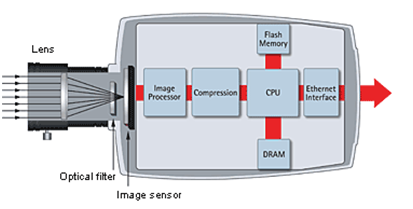
Optical Filter:
A filter that is placed in front of a colour CCD chip to break up the light into the basic colours (Red, Green, and Blue) The individual colours are then directed at different pixels on the chip.
Image Sensors:
The image sensor of the camera is responsible for transforming light into electrical signals. When building a camera, there are two possible technologies for the camera's image sensor:
- CCD (Charged Coupled Device)
- CMOS (Complementary Metal Oxide Semiconductor)
CCD sensors are produced using a technology developed specifically for the camera industry, while CMOS sensors are based on standard technology already extensively used in memory chips, inside PCs for example.
CCD technology
CCD sensors have been used in cameras for more than 20 years.
Advantages:
* Better light sensitivity than CMOS sensors.
* This higher light sensitivity translates into better images in low light conditions.
Disadvantages:
* CCD sensors are, however, more expensive as they are made in a non-standard process and more complex to incorporate into a camera.
* When there is a very bright object in the scene (such as a lamp or direct sunlight), the CCD may bleed, causing vertical stripes below and above the object. This phenomenon is called a smear.
CMOS technology
Advantages:
* Lower total cost for the cameras.
* Possible to produce smaller-sized cameras.
* 1/4 inch CMOS sensor giving you high resolution video capture at 25 frames per second
* CMOS consumes 100 times less power than CCD.
Disadvantages:
* A current limitation with CMOS sensors is their lower light sensitivity.
A filter that is placed in front of a colour CCD chip to break up the light into the basic colours (Red, Green, and Blue) The individual colours are then directed at different pixels on the chip.
Image Sensors:
The image sensor of the camera is responsible for transforming light into electrical signals. When building a camera, there are two possible technologies for the camera's image sensor:
- CCD (Charged Coupled Device)
- CMOS (Complementary Metal Oxide Semiconductor)
CCD sensors are produced using a technology developed specifically for the camera industry, while CMOS sensors are based on standard technology already extensively used in memory chips, inside PCs for example.
CCD technology
CCD sensors have been used in cameras for more than 20 years.
Advantages:
* Better light sensitivity than CMOS sensors.
* This higher light sensitivity translates into better images in low light conditions.
Disadvantages:
* CCD sensors are, however, more expensive as they are made in a non-standard process and more complex to incorporate into a camera.
* When there is a very bright object in the scene (such as a lamp or direct sunlight), the CCD may bleed, causing vertical stripes below and above the object. This phenomenon is called a smear.
CMOS technology
Advantages:
* Lower total cost for the cameras.
* Possible to produce smaller-sized cameras.
* 1/4 inch CMOS sensor giving you high resolution video capture at 25 frames per second
* CMOS consumes 100 times less power than CCD.
Disadvantages:
* A current limitation with CMOS sensors is their lower light sensitivity.
Advantages
of analogue systems over IP systems
1. Analog camera uses coaxial
cable where IP camera uses UTP cable. Coaxial cable supports up to 500 meters
where UTP supports 100
meters.
2. Virtually any analogue CCTV camera will plug in to any
DVR allowing you to easily customize and upgrade your system. An IP megapixel
surveillance system is set up specifically to work with the network protocol it
is designed for. This means different IP camera and NVR brands may not be
compatible.
3. Because the image from an analogue CCTV camera is
processed and compressed at the DVR (not the camera) it can be viewed live with
no delay. IP cameras can experience ‘lag’ for up to 2-seconds which can cause
issues in some situations.
4. Depending on the environment an analogue camera may
perform better than an IP camera in the same position. Situations where this
may occur include:
·
Low light:
The CMOS
image sensors normally used in IP cameras deliver great megapixel resolution
but do not handle low light very well. Some IP cameras will produce a grainy
picture at low light (which also uses up bandwidth and storage space because it
is interpreted as motion). Many analogue cameras use a CCD image sensor which
has much better low light performance.
·
Darkness:
Most
analogue surveillance camera include in-built IR (infrared) that allows the
camera to record images even in complete darkness. While IP cameras will record
down to a very low level of light if they need to record in zero lux separate
IR illuminators will need to be installed.
·
Fluorescent lighting: Fluorescent lighting is used in many
indoor spaces in New Zealand and it can create problems, particularly for IP
cameras. The frequency of the fluorescent lighting and the power source can
clash which creates a constant flicker on the live and recorded video image.
Accurate color information may also be affected. Note that this problem can
also affect some standard analogue CCTV cameras with CCD image sensors.
5. Analogue CCTV products are at this point in time still
cheaper than their IP counterparts – NVRs can be twice as expensive as a DVR
for example. The installation of an analogue surveillance system can also be
less expensive because they are quicker to install with minimal network set-up
and configuration.
However in some situations a single IP camera can be
installed in the place of a number of standard analogue CCTV cameras so we
always recommend looking at both options before making a final decision.
6. Overall analogue systems need little maintenance once
installed. We recommend a basic check once a week to confirm all cameras are
recording and footage can be retrieved from the DVR.
Because an analogue system is not attached to the
business or home network it won’t be at the mercy of network issues. Large file
sizes, limitations to the bandwidth, viruses or too many devices trying to use
the network (congestion) are just some of the challenges facing the
installation and ongoing maintenance of an IP system.
Analogue and Digital both camera
have mainly 3 different types
1. Dome


2. Bullet


3. PTZ
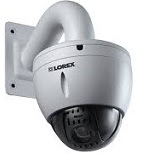
Bullet
Cameras vs. Dome Cameras
1. Bullet cameras are better for most OUTDOOR
applications and dome cameras are better for most INDOOR applications.
2. If you are looking for a long-range camera, you’ll
probably want to go with a bullet camera, as the housing of the dome camera
tends to limit the size of the lens. “The longer the
lens, the longer the range”.
3. Bullet cameras are great for outdoors
because they are usually weatherproof. We
can check the IP Ratings (Ingress Protection) of the camera to discover its
environmental protection
4. Bullets are usually easier to mount and install than
domes, as they are point-and-shoot. Attach them to the wall and we can
move manually. Dome cameras aren’t necessarily more difficult to
mount, but are more likely to require dismounting to adjust the direction. This is something to keep in mind.
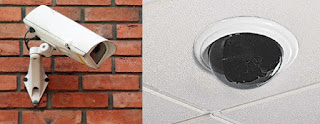
mount, but are more likely to require dismounting to adjust the direction. This is something to keep in mind.

5. Dome cameras also have a cleaner, more
seamless look due to their ability to hide/protect the wiring, whereas bullets
will often have wiring slightly exposed. Again, it is important to keep
in mind, this is not true in ALL cases, as some bullets will not have exposed
wiring and some domes will.
Pan Tilt Zoom (PTZ) Security Cameras
1. Use when you want to 'look
around' your surveillance area. PTZs allow you to manually or automatically pan
the area around your camera
2. Tilt up and down,
3. Zoom in on
anything within the sight of the lens. In automatic mode, hundreds of points
can be set for the camera to look at for any duration of time.
Optical
Zoom Vs Digital Zoom
Optical zoom
means we can bring the object near or far during capture picture by camera
lens.
After
capturing picture we can only make picture large or small in computer is called
Digital Zoom
Product Specification:
To understand the terms of
cameras, we will start from the product specification. Let’s start from analog
cameras. There are different manufacturers of analog cameras.
Here
is a specification of AVtech AVC 462B
1. Sensor - 1/3" H.R. With Sony Effio-E
2. Number of Pixels - 771(H) x 492(V) / 753(H) x 582(V)
3. Min. Illumination - 0.05 Lux; 0 Lux (IR ON)
4. Electronic Shutter - 1/60 (1/50) to 1/100,000 sec.
5. Lens - f3.8mm / F1.5
6. Lens Angle - 5
7. IRIS Mode - AES
8. IR LED - 35 units
9. IR Effective Distance - Up to 25 meters
10. White Balance - ATW
11. AGC - Auto
12. IP Rating - IP67
13. Operating Temperature - −20℃~ 40℃
14. Power Source (±10%) - DC12V
15. Current / Power consumption (±10%) - 70mA (IR OFF), 400mA (IR ON)
16. Dimensions (mm) - 142(H) x 75(Φ)
1. Sensor
1. Sensor - 1/3" H.R. With Sony Effio-E
2. Number of Pixels - 771(H) x 492(V) / 753(H) x 582(V)
3. Min. Illumination - 0.05 Lux; 0 Lux (IR ON)
4. Electronic Shutter - 1/60 (1/50) to 1/100,000 sec.
5. Lens - f3.8mm / F1.5
6. Lens Angle - 5
7. IRIS Mode - AES
8. IR LED - 35 units
9. IR Effective Distance - Up to 25 meters
10. White Balance - ATW
11. AGC - Auto
12. IP Rating - IP67
13. Operating Temperature - −20℃~ 40℃
14. Power Source (±10%) - DC12V
15. Current / Power consumption (±10%) - 70mA (IR OFF), 400mA (IR ON)
16. Dimensions (mm) - 142(H) x 75(Φ)
1. Sensor
(a)
Size:
Geometric
size of the sensor, measured in inches. There are cameras with 1",
2/3", 1/2", 1/3", 1/4" and 1/6" sensors. The most
popular size is 1/3". Generally, the larger sensor, the higher sensitivity
(within the same category).
The size of the image sensor determines the
minimum size of the lens. In general, larger sensors can provide higher
image quality. This is due to the possibility of implementing more pixels.
Currently, even 1/4" sensors can provide satisfactory results.
(b) H.R. means here High Resolution.
(c) Image Processor:
Currently,
most image processing systems are based on digital signal processors (DSPs).
The image sensor and signal processor can be compared to the eye and brain of
the camera. The signal processor collects and modifies the signal generated by
the sensor. The algorithms are stored in its memory, and can be activated by
the user as selectable settings or functions of the camera, intended for
various environmental conditions.
Sony Effio DSPs:
Sony Effio is a modern platform providing images with high quality and
resolution.
There are three versions of Effio DSPs: Effio-E , Effio-S and Effio-P.
There are three versions of Effio DSPs: Effio-E , Effio-S and Effio-P.
Effio-E: (Entry
level version) can cooperate with CCD image sensors having (horizontally) from
510 to as much as 960 pixels (the horizontal video resolution of some cameras
with this DSP can exceed 650 TV lines). The DSP performs advanced operations
including image analysis and image modifications, depending on the selected
functions (e.g. motion detection, privacy masking, noise reduction, HLC, ATR).
Effio-S DSP has been enriched with:
Effio-S DSP has been enriched with:
·
3D noise
reduction - comparison of consecutive frames with separation of color and B/W
information - more precise noise reduction with less motion blurring artifacts,
·
E-Zoom -
digital zoom without losing image quality,
·
Sense-Up function (digital slow shutter speed multiplying sensitivity in
extremely low-light),
·
Digital Image Stabilization (DIS),
·
more advanced ATR (Adaptive Tone Reproduction) which digitally improves
image quality of scenes with very strong differences in light intensity
Effio-P is the
most professional signal processor of the series. In relation to Effio-S, it
supports the most advanced image sensors that scan the image twice (with
different exposure parameters). This feature is called "true" WDR
(Wide Dynamic Range) and effectively reduces overexposure.
2.
Resolution: 771(H) x 492(V) / 753(H) x 582(V):
For
standard analog cameras, resolution is measured by TVL (TV Lines). For
most new analog cameras the TVL range is 420 to 700. .
There are different formats of video that are used in
different geographical areas. NTSC (National Television System Committee)
format is used in North and South America, Japan, and Taiwan and many other
areas. PAL (Phase Alternating Line) format is used primarily in Africa, Asia,
New Zealand, Australia, and the majority of Europe.
Here, 771(H) x 492(V) is
NTFS format & 753(H) x 582(V) is PAL format. That means it supports both
format.
Analog surveillance video resolution is measured in terms
of broadcast TV lines as viewed on a monitor screen that are the combination of
pixels. Here, 753 pixel horizontal and 582 pixels vertical. The higher this
number is, the better the picture.
The digital recording resolution can be expressed in
effective pixel dimensions.
Typical
pixel dimensions:
480
TVL
|
510
x 492
|
600
TVL
|
768
x 494
|
650
TVL
|
811
x 508
|
700
TVL
|
976
x 582
|
A camera that can produce an image size of 640X480 would
contain 307,200 pixels. A camera capable of producing an image size of
3872×2592 = 10,036,224 pixels = 10 megapixels.
3. Illumination: 0.05 Lux; 0 Lux (IR ON)
Day and
night functionality:
The
level of light a security camera needs to capture a good picture is referred to
as the camera’s lux and the lower the lux the better a camera can see in low
light. For example a camera with 0.002 lux will see better in low than a camera
with 0.3 lux.
IR (Infrared) surveillance
cameras can operate in what is called ‘zero lux’ conditions or in other words,
where there is no light, such as at night. These cameras all have small
LEDs that transmit infrared light out around the camera lens lighting up the
area and allowing the camera to record in the dark. Infrared light is invisible
to the human eye but not to the camera. The distance the camera can “see”,
or its night vision range, depends on the number of LEDs it has. (See here
number 8 & 9 specification).
Infrared CCTV cameras will record in color during the day
and then once the light drops below a minimum level (here it tells .05 Lux)
they will switch to black & white (monochrome) recording. They will then
switch back to color once the light level increases.
4. AES (Automatic
Electronic Shutter)
The term shutter comes from still photography,
where it describes a mechanical "door" between the camera lens and
the film. When a photo is taken, the door opens for an instant and the film is
exposed to the incoming light. The speed at which the shutter opens and closes
can be varied — the faster the speed, the shorter the period of time the
shutter is open, and the less light falls on the film.
Shutter speed is measured in fractions of a second. A
speed of 1/60 second means that the shutter is open
for one sixtieth of a second. A speed of 1/500 is faster, and 1/10000 is
very fast indeed.
Video camera shutters work quite differently from still
film camera shutters but the result is basically the same. (The technical
difference is that, rather than using a mechanical device, the shutter speed is
adjusted by electronically varying the amount of time the CCD is allowed to
build a charge.)
The shutter "opens" and "closes" once
for each frame of video; that is, Frame rates 25 fps (Frame per Second) for PAL and
30 fps for NTSC. Some specialist cameras can have a very high frame rate. Thus,
if a camera has its shutter set to 1/60, each frame will be exposed for 1/60
second. If the speed is increased to 1/120, each frame will be exposed for
1/120 of a second. Remember, the shutter speed does not affect the frame rate,
which is completely separate.
·
Frame rate = How many individual frames
are created each second.
·
Shutter speed = How long each individual
frame is exposed for or shutter open.
The main effect of higher shutter speeds is that
individual frames appear sharper, due to the minimization of motion blur.
Motion blur occurs when the subject moves within the frame while the shutter is
open. The less time the shutter is open (i.e. the faster the shutter speed),
the less movement will take place.
In the picture shows the motion blur changes depends on shutter speed.
Shutter Off
In the picture shows the motion blur changes depends on shutter speed.
Shutter Off
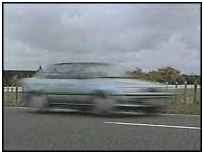
1/120 second
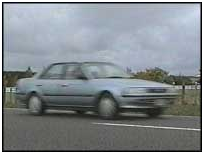

1/500 second
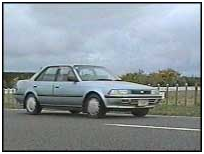
Note: As a result of the reduced exposure
time with high shutter speeds, the image may appear darker unless the iris is
opened to compensate.
Aperture
& Shutter Speed:
Since both the aperture and shutter speed
control amount of light reaches the film for an exposure, there is a very
strong relationship between the two:
1. The
aperture (how big or small the lens diaphragm inside a lens opens up) allows
different amount of light falls onto film through the lens that attached on
your camera body and;
2. The
shutter speed (the shutter curtain - duration and how long it opens up to absorb the
amount of light falls onto film).
AES - (Automatic
Electronic Shutter) is used when a manual or fixed iris lens is fitted and the shutter
speed will respond to the amount of light to keep the signal output at optimum
level. AES allows changing the iris level automatically without using the auto
iris lens.
Auto iris lens:
Auto iris lens
is a lens with a built-in method of automatically controlling the lens aperture
for the best video quality under diverse and changing lighting conditions.
Auto-iris lenses can be especially helpful under very low light and bright
direct forward light.
When the electronic shutter is off, the shutter speed is set as 1/60sec
for NTSC system and 1/50 sec for the PAL system. When the electronic shutter is
on, the electronic shutter can be set in steps from 1/60sec to 1/10000secs for
NTSC system and in steps from 1/50sec to 1/10000 secs for PAL system. When the
shutter speed increases, the light passing through the lens will decreases and
the camera sensitivity will be reduced.
However, when shooting fast moving objects, the increased speed can
provide freezing effect for the object image, thus providing better resolution.
The AES should be switched off when an Auto Iris Lens is fitted.
5. Lens:
Here, specification is f3.8mm /
F1.5
For example
on a Canon EF-S 17-85mm f/4-5.6 lens you will see the number 17-85mm written on
the side. The mm number refers to the focal length. This is the length or
distance from the front of the lens to the camera's sensor. The focal length is
one of the most important considerations a photographer needs to take into
account when buying a new lens. The mm number (distance in millimeters from the
front of the lens to the sensor) will determine the style of photograph that
can be taken.
The smaller the mm number the wider the angle of view
within a photograph. Big mm numbers like 200mm or 300mm provide a magnified
telephoto view. They are good for animal photography where you might want to
zoom in on a bird yet not be too close and scare it away.
The difference between a lens that has a single mm number to one
that has two mm numbers.
If a lens has a single mm number, for example 100mm
written on it, it is said to be a prime lens. This means the focal length of
the lens is fixed and cannot be changed.
If a lens has two mm numbers on it, for example 17-85mm,
this tells you it is a zoom lens. In other words it can take photographs with a
17mm focal length or zoom in all the way to a 85mm length.
Here we found f3.8mm. That means this is fixed lens with
focal length 3.8mm
What does the ratio number mean?
You might also notice a number written on your lens that
looks like a ratio. For example 1: 4 - 5.6
This number refers to the widest aperture available for
that lens. The lens in the example above can be opened up to f/4 at the widest
end (17mm) but only f/5.6 at the longest end (85mm). Generally speaking, the
lower the f numbers the better, because in low light situations the lens can be
used to give a brighter image.
Note also,
the 1: part of the number is there purely because f stops or aperture is
measured in ratio.
For a quick
1/3" CCD Camera you can work out the lens required using this simple
method: Distance from object (D) multiplied by 4.8, divided by horizontal or vertical
area (A) equals the lens required (L).
Focal Length = Distance x 4.8 / viewing
area
If focus on an area 5m wide from a camera installed 20m away would be:
= 20 x 4.8 / 5
= 19.2
so you would need a lens with a focal length of 19.2mm
so you would need a lens with a focal length of 19.2mm
Example Lens Size Vs Horizontal Field of View:
3.6mm
|
6mm
|
8mm
|
12mm
|
|
Horizontal Field of
View(degress)
|
72
|
44
|
33
|
23
|
So here, Prime
lens: f3.8mm
And another is
F Stop (F1.5)
F Stop
The F stop is the focal length divided by the effective
aperture diameter. In much simpler terms, the F Stop is an indication of
the speed of the lens. Since light must pass through the lens to the
sensor, the F Stop gives us an idea of how much light it will absorb during the
process. A low F Stop lens is very efficient whereas a high F stop lens
will require a lot of light.
F Stop or
Aperture has 2 measurements. When the lens is fully open (Maximum Aperture /
Minimum F-Stop), just before the lens completely closes (Minimum Aperture / Maximum
F-Stop).
F Stop - is the lenses ability to gather light depending on the aperture and focal length.
F Stop - is the lenses ability to gather light depending on the aperture and focal length.
Aperture:
When you look at the technical specifications of a
digital camera, one of the very first specifications mentioned is its maximum
aperture and/or its aperture range.
What is 'aperture,' what is a good aperture range, and
how is aperture relevant when it comes to choosing a digital camera?
The main function of a camera lens is to collect light.
The aperture of a lens is the diameter of the lens opening and is usually
controlled by an iris. The larger the diameter of the aperture, the more light
reaches the film / image sensor.
Aperture is expressed as F-stop, e.g. F2.8 or f/2.8. The smaller the
F-stop number (or f/value), the larger the lens opening (aperture).
[Note: Many camera user manuals today will refer to the
aperture in terms of "aperture value" instead of f/value. I'm not
sure when this trend started but don't get confused between
"aperture" and "aperture value." Aperture value" is
simply another way of saying f/value.]
In practice, unless you are dealing with a fixed-aperture
lens (many simple point-and-shoot cameras have only one fixed aperture), the
aperture of a lens is usually expressed as a range of f stops.
When you read the specifications of a camera, the
aperture may be expressed in a number of different ways, the following three
being the most common:
Maximum
Aperture: F2.8
This simply states that the maximum aperture for the lens is F2.8.
This simply states that the maximum aperture for the lens is F2.8.
Aperture
Range: F2.8 - F8.0
This states the max and min aperture, the assumption being that there are standard increments between them.
This states the max and min aperture, the assumption being that there are standard increments between them.
Maximum
Wide-Angle and Telephoto Apertures: F2.8-3.5 or
F2.8(W)-F3.5(T)
This gives the max aperture for the wide-angle (F2.8) and telephoto (F3.5) focal lengths of a zoom lens.
This gives the max aperture for the wide-angle (F2.8) and telephoto (F3.5) focal lengths of a zoom lens.
Quick Quiz: which lens has a larger opening (aperture):
one with an aperture of F1.8 or one with an aperture of F2.8?
Answer: F1.8 (remember, the smaller the F-stop, the larger the aperture)
Answer: F1.8 (remember, the smaller the F-stop, the larger the aperture)
A Good Aperture Range
My personal preference for a 'good' aperture range is: F1.8
- F16
F1.8
|
F2.8
|
F4
|
F5.6
|
F8
|
F11
|
F16
|
This tells us that the camera has an aperture range of F1.8 to F16; the maximum aperture is F1.8, and the minimum aperture is F16.
There are 5 f-stops between the max and min aperture. If
your camera's lens is currently set at an aperture of F5.6, closing it by 1
f-stop would mean selecting F8; opening it up by 1 f-stop would mean selecting
F4.
F1.8
|
F2.8
|
F4
|
F5.6
|
F8
|
F11
|
F16
|
How Is A Large Maximum Aperture
Relevant?
A large maximum aperture is preferable to a
smaller one since it gives the photographer more latitude in the kind of pictures
that can be taken.
For example, it is pretty obvious that the larger the
aperture, the better your digital camera will perform in low-light situations, since a larger
lens opening is able to admit more light than a smaller lens opening.
A larger max aperture also allows you to use a faster shutter speed to freeze action.
So, let's say the light meter in your digital camera
calculates that for proper exposure in that indoor arena, you need an aperture
of F4 and a shutter speed of 1/60 sec.
F4
|
1/60
|
To use a faster shutter speed (say, 1/250 sec.) to freeze
action, you have to open up the aperture to allow more light in for that
shorter amount of time.
For every shutter speed increment we go up, we need to
open up an f-stop of aperture. From 1/60 sec. to 1/250 sec. there are 2
increments, so we open up the aperture by 2 f-stops, going from F4 to F1.8.
Note that the camera would give proper exposure at 1/60 sec. at F4, 1/125 sec.
at F2.8, and 1/250 sec. at F1.8, since all three aperture/shutter speed combinations
allow the same amount of light into the camera.
F1.8
|
F2.8
|
F4
|
F5.6
|
F8
|
F11
|
F16
|
1/250
|
1/125
|
1/60
|
1/30
|
1/15
|
1/8
|
1/4
|
Of course, in a digital camera set on Auto mode, you can
select Sports scene mode, and the camera will automatically select a fast
shutter speed and the appropriate aperture. Likewise, in Shutter-Priority mode,
you can choose which shutter speed you want (fast or slow), and the camera will
select the appropriate aperture for proper exposure.
In our example above, let's say the lens on your digital
camera only opens up to a max aperture of F2.8. If you now select 1/250 sec.
(in Shutter-Priority mode), the camera will not be able to select an aperture
larger than F2.8 (in our example, it really needs F1.8). It would then give you
an "underexposure" warning. If you go ahead and take the picture
anyway, your picture would be 1 f-stop underexposed (i.e. you really needed to
open up the aperture by 1 more f-stop for correct exposure).
Similarly, if you select a shutter speed of 1/4 sec. and
the lens only closes down to a min. aperture of F8 (in our example, it really
needs F16), the camera would give you an "overexposure" warning. If
you go ahead and take a picture anyway, your picture would be 2 f-stops
overexposed (i.e. you really needed to close down the aperture by 2 more
f-stops for correct exposure).
A large maximum aperture is a good thing. It allows more light
to reach the image sensor, and so allows you to use a faster shutter speed. A
faster shutter speed freezes action and negates the effect of camera shake,
resulting in pictures that are not blurred.
Another advantage of a large maximum aperture is to
provide a shallow depth of field. This allows the background to blur nicely
thus isolating your subject (especially effective when taking portraits).
A small minimum aperture is also a good thing. It allows you
to use a slow shutter speed on a bright sunny day. A slow shutter speed allows
you to depict motion.
Another advantage of a small minimum aperture is to
increase the depth-of-field. An increased depth-of-field allows you to take
landscape pictures where as much of the picture in the foreground and reaching
all the way to the background (usually, 'infinity') is in sharp focus.
7.
IRIS Mode: AES
Iris:
The iris works with the surveillance camera lens to
control the amount of light entering the camera via the sensor. For
cameras mounted in positions that have changing light sources, it is a good
idea to use a lens with an automatic iris. For cameras used inside or in
environments where the light conditions seldom ever change, manual irises are
sufficient.
IRIS lenses are several types
Auto iris lenses are a fantastic choice for
outdoor surveillance where light is constantly changing. The iris for these
lenses automatically opens and closes according to the amount of ambient light
so that your video feeds are not affected by the change in lighting conditions.
Auto iris (DC and video)
There are two types of auto iris lenses: DC iris and
video iris. Both have a motor-driven, automatically adjustable iris opening that
responds to changes in light levels. Both also use an analog signal (often
analog video signal) to control the iris opening. The difference between the
two is where the circuitry to convert the analog signal into motor control
signals is located. In a DC-iris lens, the circuit resides inside the camera;
in a video iris, it is inside the lens.
In bright situations, a camera with an auto iris lens can
be affected by diffraction and blurring when an iris opening becomes too small.
This problem is especially prominent in megapixel and HDTV cameras since the
pixels in the image sensors are smaller than standard resolution cameras.
Therefore, the image quality is more dependent on getting the right iris
opening (aperture). In order to optimize image quality, a camera needs to have
control over the position of the iris opening. The problem with an auto iris
lens is that this control cannot be made available to the camera or user.
Manual iris lenses are well suited for areas
with consistent lighting like shopping centers, schools, libraries, and offices
because the iris only needs to be set once during the installation of the lens.
Manual lenses are less expensive than their auto counterpart since they do not
come with the auto-adjust mechanics, but are more limited because of that
distinction.
The ability to control a camera’s iris opening plays an
important role in image quality. An iris is used to maintain the optimum light
level to the image sensor so that images can be sharp, clear and correctly
exposed with good contrast and resolution. The iris can also be used to control
the depth of field.
Iris control can be fixed or adjustable. Adjustable iris
lenses can be manual or automatic (auto iris and P-Iris).
Fixed iris
In indoor environments where light levels may be
constant, a fixed iris lens can be used. With fixed iris lenses, the iris
opening cannot be adjusted and is fixed at a certain f-number. The camera can
compensate for changes in the level of light by adjusting the exposure time or
using gain.
P-Iris:
In bright situations, P-Iris limits the closing of the
iris to avoid blurring (diffraction) caused when the iris opening becomes too
small. This can typically happen in cameras that use DC-iris lenses in
combination with megapixel sensors that have small pixels. Being able to avoid
diffraction and at the same time benefit from an automatically controlled iris
is highly valued in outdoor video surveillance applications.
A P-Iris lens uses a motor that allows the position of
the iris opening to be precisely controlled. Together with software that is
configured to optimize the performance of the lens and image sensor, P-Iris
automatically provides the best iris position for optimal image quality in all
lighting conditions.
AES - (Automatic
Electronic Shutter)
AES is used when a manual or fixed iris lens is fitted and the shutter
speed will respond to the amount of light to keep the signal output at optimum
level. AES allows changing the iris level automatically without using the auto
iris lens.
When the electronic shutter is off, the shutter speed is set as 1/60sec
for NTSC system and 1/50 sec for the PAL system. When the electronic shutter is
on, the electronic shutter can be set in steps from 1/60sec to 1/10000secs for
NTSC system and in steps from 1/50sec to 1/10000 secs for PAL system. When the
shutter speed increases, the light passing through the lens will decreases and
the camera sensitivity will be reduced.
However, when shooting fast moving objects, the increased speed can
provide freezing effect for the object image, thus providing better resolution.
The AES should be switched off when an Auto Iris Lens is fitted.
10.
White Balance: ATW
Accurate white balance ensures that white objects in your
video appear white, in addition it ensures that colors look natural and similar
to the colors you see with your own eyes while shooting the scene.
The cameras auto mode, often called ATW (auto tracing
white balance)
11. AGC: Auto
Abbreviated
as AGC, automatic gain control is a circuit found
on some electronic devices that automatically controls the gain of a signal.
Using AGC means that weaker signals receive more gain and stronger signals
receive less gain or none at all.
12.
IP Rating: IP67
Ingress Protection
ISO Standards for rating of protection from rain and
dust.
First IP Digit – Protection
from Solids
The
rating consists of numeric values. The first digit is a number (0-6)
which indicates the size of the particles for which the enclosure is rated.
A rating of 5 means it is protected against dust though there can be a
nominal amount of dust that might intrude the enclosure, but a 6 means it is an
enclosure that eliminates all dust. CCTV camera enclosures should always
come with a rating of 6, dust-free.
Second IP Digit – Protection
from Liquids
The
second digit of the rating is a number (0-9) which describes the potential for
intrusion by water. A number of 4 means that splashing water from any
side will not have a harmful effect on the protected mechanical or electrical
component encased. 8 mean that the enclosure can be continuously immersed in
water over one meter in depth. 7 means it can protect internal devices in an
immersed condition up to one meter in depth, but it is approved for this rating
by testing for only thirty minutes.
An IP rating of IP 67 means that it is an enclosure that
can be considered as dust-free and it can withstand submersion in water for no
longer than thirty minutes and not over one meter in depth.
Here is an IP (Ingress Protection) Chart
demonstrating each digit with illustrated examples of enclosure protection
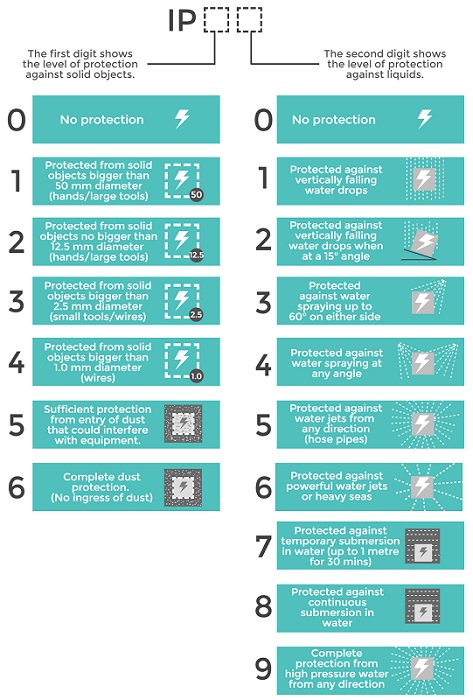
12 Dimensions (mm): 142(H) x 75(Φ)
Phi (uppercase Φ, lowercase φ,
or math symbol ϕ, also fi), pronounced FY
or sometimes FEE in English.
This is camera body size.
These are the basic specifications of a camera. Now need to know other devices we need to install camera.
These are the basic specifications of a camera. Now need to know other devices we need to install camera.
Devices require for installing Digital Camera click here
See more Related Post:
Storage Calculation
Bandwidth Calculation
DVR configuration - AVTech
Click image to go:
to share this page with your friends, select below


No comments:
Post a Comment